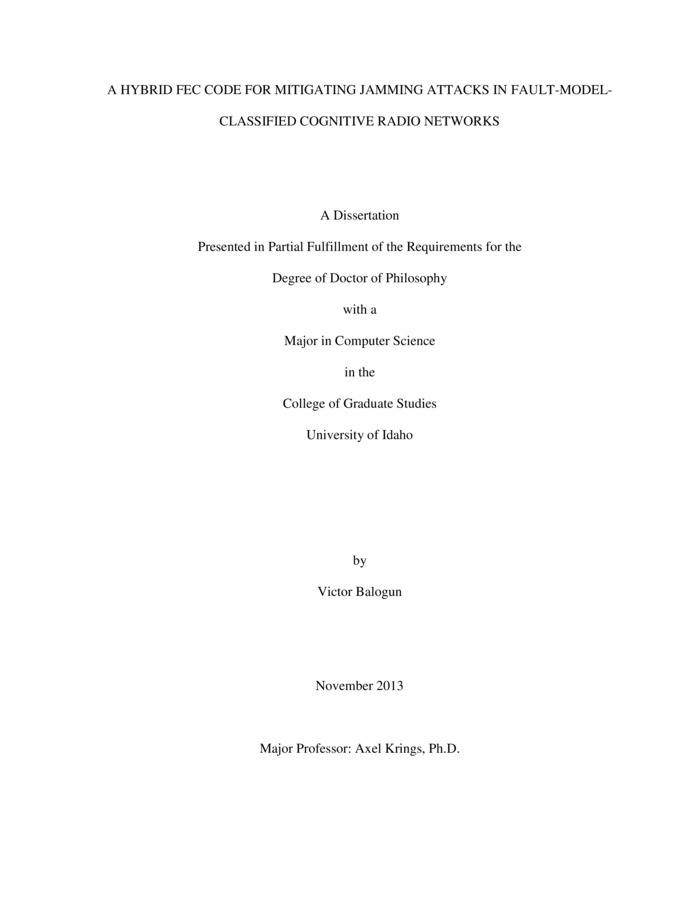Please note: this collection is no longer updated. Visit our Theses and Dissertations Collection in VERSO for all U of I ETD since 2012.
ETD PDF
A Hybrid FEC Code for Mitigating Jamming Attacks in Fault-Model-Classified Cognitive Radio Networks
Citation
Balogun, Victor Folorunso. (2013). A Hybrid FEC Code for Mitigating Jamming Attacks in Fault-Model-Classified Cognitive Radio Networks. Theses and Dissertations Collection, University of Idaho Library Digital Collections. https://www.lib.uidaho.edu/digital/etd/items/etd_401.html
- Title:
- A Hybrid FEC Code for Mitigating Jamming Attacks in Fault-Model-Classified Cognitive Radio Networks
- Author:
- Balogun, Victor Folorunso
- Date:
- 2013
- Keywords:
- Cognitive Radio Networks Fault Models Forward Error Correction Codes Jamming Recovery Block Simulation Computer science
- Program:
- Computer Science
- Abstract:
- Opportunistic sharing of spectrum through the concept of Cognitive Radio network (CRN) has been considered the next stage in the effort of the government to alleviate the spectrum shortage problem. The idea is to salvage spectra that are rendered fallowed by the licensed (primary) users during their on and off period. Recent literature reiterated that this next generation wireless network is capable of providing ubiquitous connectivity of high-bandwidth communications to both urban and rural communities. It has diverse application domains ranging from distance education to other government-delivered essential services like remote health care delivery and emergency rescue response. The security requirements of CRN must be specified because of the sensitive nature and variety of application domains of the network. Violation of any of the requirements, either maliciously or inadvertently, by users like jammers constitute security threats that will significantly affect the trust and acceptance of the public and further use of the technology. The task of mitigating malicious attacks, especially jamming in this type of network, is very challenging. This is because potential attackers could be operating as Cognitive Radios themselves, and as a result they are capable of preying on the adaptable and reconfigurable features of CRN with the intent of causing serious denial of service to the users of the network. In addition, it will be shown that these jammers are capable of introducing value faults in pathological cases. In this research, we first classified CRNs using a hybrid fault-model taxonomy that considers different fault types including omissive and transmissive value faults. Through simulation, we investigated the performance of CRNs operating in the presence of jamming attacks that are capable of introducing value faults. We observed through performance evaluation like Packet Delivery Ratio (PDR) that these jammers are very effective in their operations and they could bring down the entire CRNs, leading to close to zero packet being delivered by the networks to the destination, even when the rate of jamming is just about 30%. We also discovered that none of the existing solutions are able to mitigate these malicious attacks. As a result, a hybrid forward error correction (FEC) code is proposed that incorporates data integrity checking into an efficient forward error correction mechanism. The new hybrid FEC code is defined as the concatenation of the Raptor code and the Secure Hash Algorithm-2 (SHA-2). We use the Raptor code part of the code to recover data loss, since Raptor code is an FEC code that allows encoded communicated data to be recovered at the destination without the need for a re-transmission, with high probability even when some of the data is lost due to jamming. The SHA-2 part of the code is used to verify the integrity of data received at the destination since CR jammers are capable of manipulating transmitted data. This is possible because SHA-2 can transform any set of data elements into a unique fixed length hash value, which can be verified at both the sender and the receiver for any data manipulation by CR jammers. When data communicated is detected to be lost or manipulated, the approach explores a recovery block based on the application scenario. The algorithm for our proposed solution is presented and its validity and threshold functions are established. We simulate our proposed solution in NS-2 and evaluate its performance by comparing it with ordinary FEC code implementation. The result of the analysis using suitable performance metrics shows that the proposed solution is very efficient and robust against the different rates of jamming perpetrated by CR jammers in a fault-model classified CRN. In addition, the encoding and decoding algorithm of the proposed hybrid FEC code was found to be very efficient because of the observed high recovery rate of the algorithm capable of providing consistent low packet loss ratio (PLR), even at the jammers worse case scenario of 100% jamming rate.
- Description:
- Thesis (Ph. D., Computer Science)--University of Idaho, December 2013
- Major Professor:
- Axel Krings
- Type:
- Text
- Format:
- application/pdf
Rights
- Rights:
- In Copyright - Educational Use Permitted. For more information, please contact University of Idaho Library Special Collections and Archives Department at libspec@uidaho.edu.
- Standardized Rights:
- http://rightsstatements.org/vocab/InC-EDU/1.0/

